|
Tule
Ponds at Tyson
BIRDS OF PREY
|
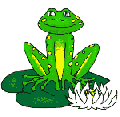 |
|
Birds of prey have powerful taloned feet
for grasping and killing, and hooked beaks for tearing flesh. They
include daytime hunters such as kites, vultures, hawks, eagles and
falcons; and owls, which are nocturnal hunters. The following birds of
prey have been observed at Tyson Lagoon: |
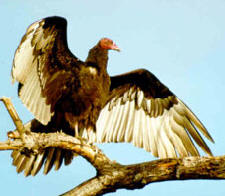 Turkey Vulture Turkey Vulture
Cathartes aura
Turkey vultures
are large eagle-like birds, with 2-toned blackish wings and small
red naked heads. “Kettles” of vultures are often seen soaring in
wide circles with their wings held in a “V” position (dihedral).
They rock from side to side riding thermals of rising air and seldom
flap their wings. Vultures feed on the flesh of dead animals
(carrion). |
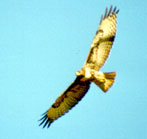 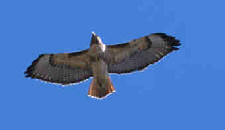 Red-tailed Hawk Red-tailed Hawk
Buteo
jamaicensis
The red-tailed
hawk is our most common hawk. Most adult red-tails have a dark head
and belly band of dark streaks on whitish underparts. The
distinctive fan shaped red-tail is visible when the hawks are
soaring overhead. Their call is a harsh, descending keeeeer. |
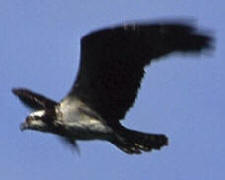 Osprey Osprey
Pandion
haliaetus
The osprey is a
large fish-eating hawk. It is dark brown above and white
below. The head is white with a dark eye stripe. It
hovers with beating wings and plunges feet first to catch fish.
An osprey sometimes perches on the dead eucalyptus tree on the west
side of Tyson Lagoon. |
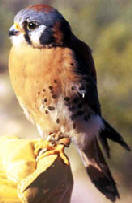 American Kestrel American Kestrel
Falco sparverius
The American
kestrel is the smallest and most common of our falcons. It has a
russet back and tail, and two black stripes on a white face. The
male has blue-gray wings. Kestrels feed on insects, small reptiles
and mammals and hover over their prey before plunging to seize them
in their talons. They were formerly called sparrow hawks because
they may feed on small birds in winter. Their call is a shrill,
loud killy killy killy. |
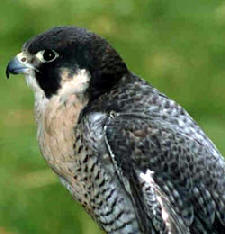 Peregrine Falcon Peregrine Falcon
Falco peregrinus
The peregrine
falcon has a characteristic black helmet and a heavy black
“mustache”. Adults have slate-colored backs and are pale below with
bars and spots. Peregrine populations declined drastically because
DDT caused their egg shells to become so thin that they broke when
incubated. Since DDT has been banned, peregrine falcons have
increased in numbers. Peregrine falcons have been observed flying
over Tyson Lagoon. |
|